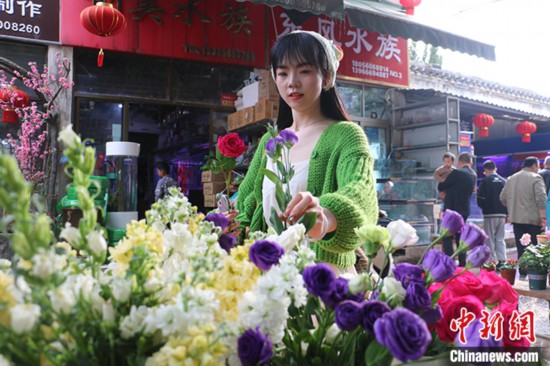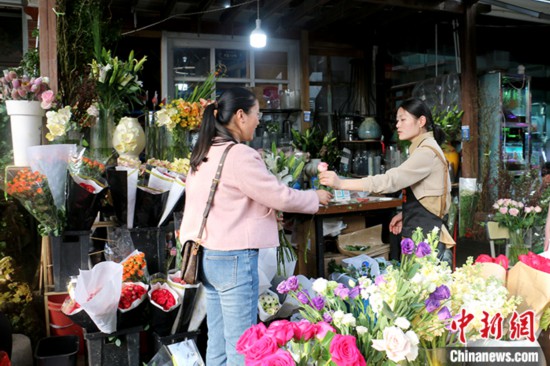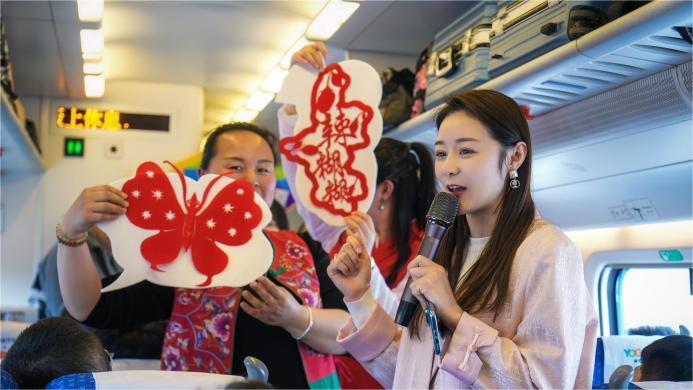Spring blooms at home: Young consumers make flower consumption mainstream
Young people in China are embracing flower consumption as a way of bringing the essence of spring into their homes. Buying flowers represents not only a sense of ritual but is also emerging as an important way for young people to find joy.

Flower stall owner Zhan Yinyin, a member of Generation Z, selects flowers at a flower, bird, fish and insect market in Hefei, east China's Anhui Province, on March 23, 2024. (China News Service/Zhang Qiang)
According to Ni Xiangnan, a woman born in the 1990s, flowers symbolize personal romance and provide a sense of ritual in her busy life.
"My flower consumption is not limited to specific times or places. Whether it's on my way home from work, during a leisurely stroll in the park, or while shopping, I seize the opportunity to buy flowers whenever I find flowers I like. I prefer to buy only a few stems, as they are easier to manage," said Ni.
Data from online platforms shows a notable rise in attention to flower and bird markets since March. Cities like Shanghai, Wuhan, and Hangzhou have seen the highest increase in search volume, with local flower and bird markets becoming popular destinations, seeing a remarkable 400 percent surge in search volume.
Wang Yunfei, an associate professor at the Department of Sociology at Anhui University, believes that the normalized flower consumption among young people serves as a form of psychological relief amidst the pressures of life.
As buying flowers becomes more common, it has also driven the growth of flower markets. Each part of the chain, from flower markets to wholesalers, retailers, and consumers, contributes to the thriving of the flower industry.
Yuan Yuan has been operating a flower shop in Hefei, east China's Anhui Province, for a decade.
"Since March, the flower market has been in its peak season, and we have witnessed robust sales both online and offline, during holidays and regular days. To cater to the market demand, we have embraced a dual approach of wholesale and retail. Notably, our retail customer base is made up primarily of young individuals," Yuan explained.

A citizen buys flowers at a flower shop in Hefei, east China's Anhui Province, on March 23, 2024. (China News Service/Zhang Qiang)
"Seasonal flowers are budget-friendly, but they don't last long. Although the price of roses has been relatively high lately, they are still seeing good sales," Yuan explained.
In today's market, flower prices are transparent, and thanks to the continuous advancements in modern flower logistics and distribution networks, prices have significantly decreased. Businesses now strive to compete by offering innovative services.
Hefei's Huaihe Road Pedestrian Street is a popular late-night hangout spot for young people, and is where Zhan Yinyin sells flowers. As a member of Generation Z, Zhan is not only a livestreamer but also co-owns a tea room with her friends.
"I have a genuine passion for flowers. Setting up a flower stall doesn't require high costs, and I can earn a few thousand yuan (one yuan equals about $ 0.14) per month," said Yuan.
Feng Huaibin, general manager of the Kunming International Flora Auction Trading Center, believes that the fresh-cut flower market in China is thriving. With its diverse range of flowers and improving quality, the market is driven by robust consumer demand.
Notably, data analysis from e-commerce platforms indicates a substantial rise in the number of consumers, particularly among the younger generation, who look for high-quality, personalized, and affordable floral products. This positive growth trend is expected to continue over the next decade.
Photos
Related Stories
Copyright © 2024 People's Daily Online. All Rights Reserved.









